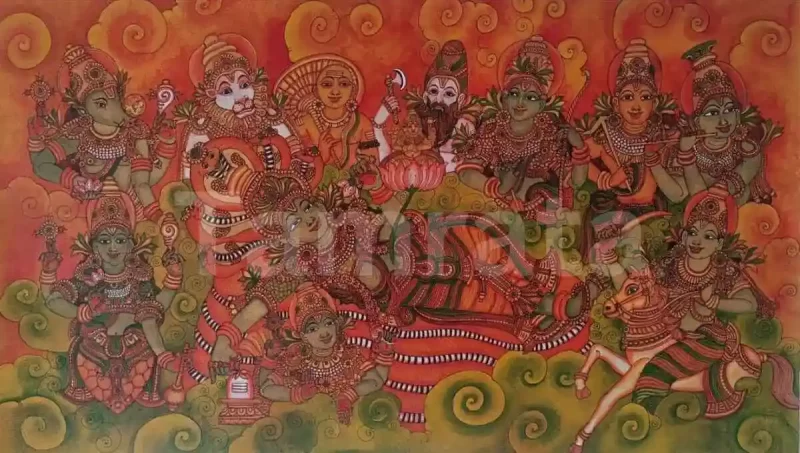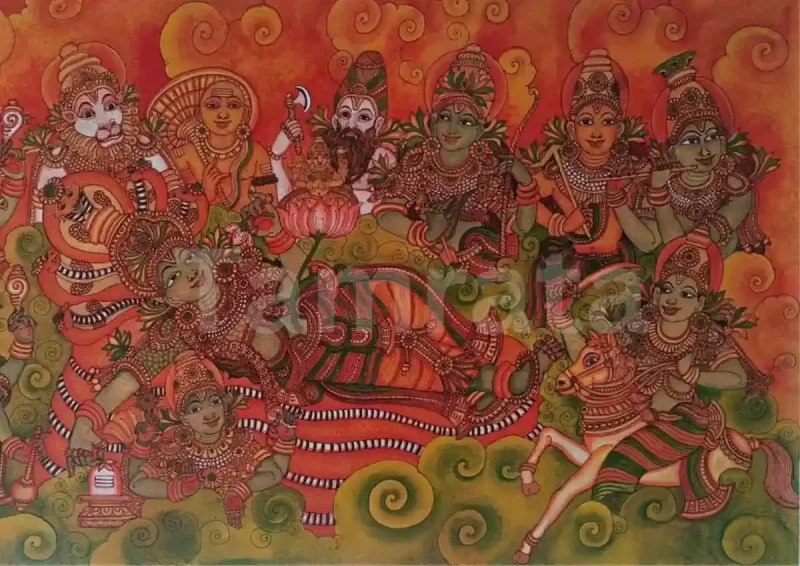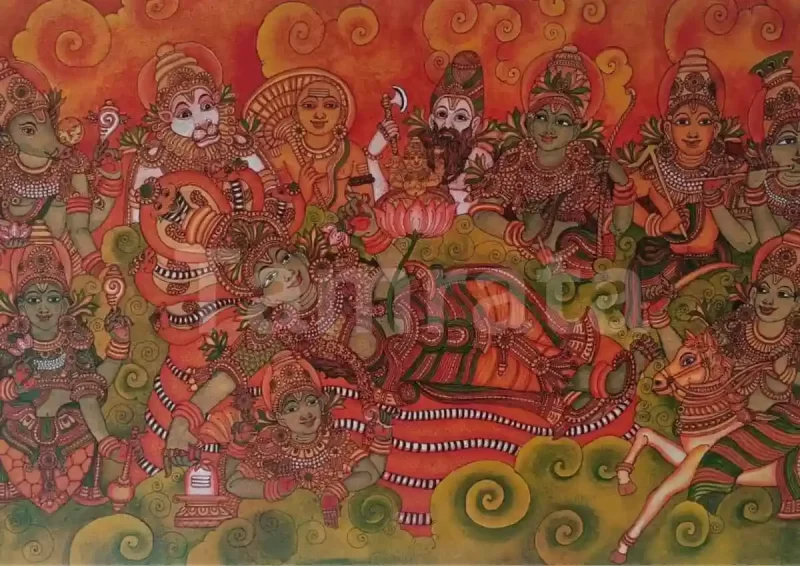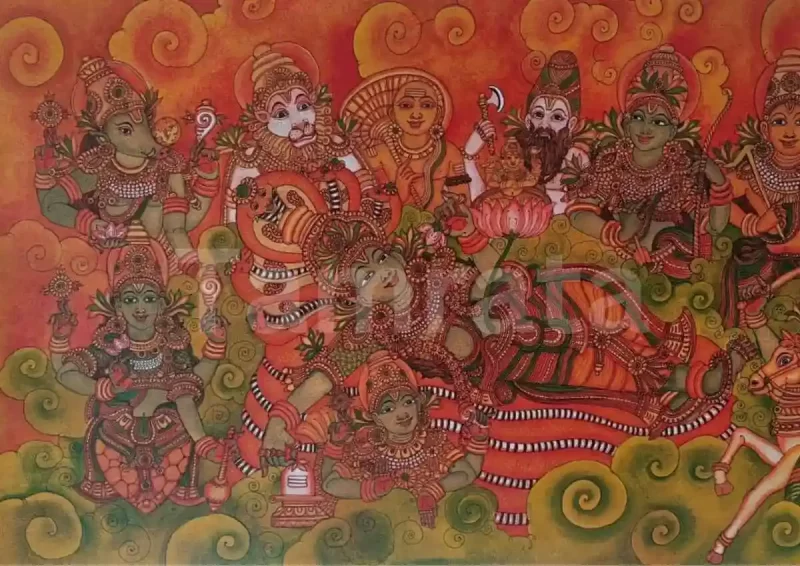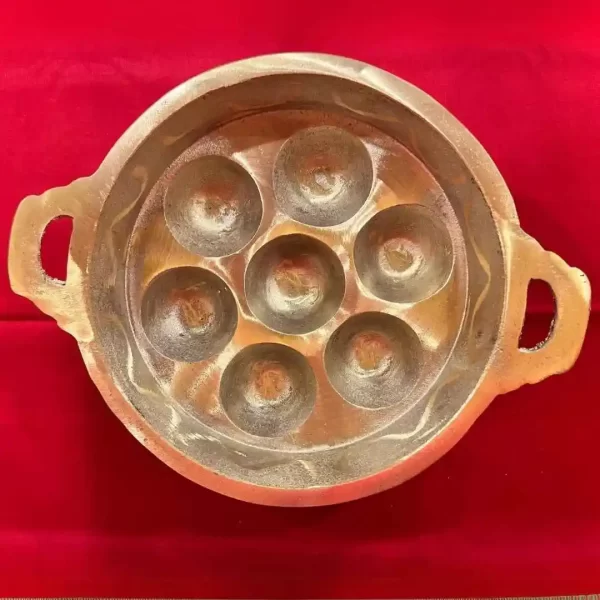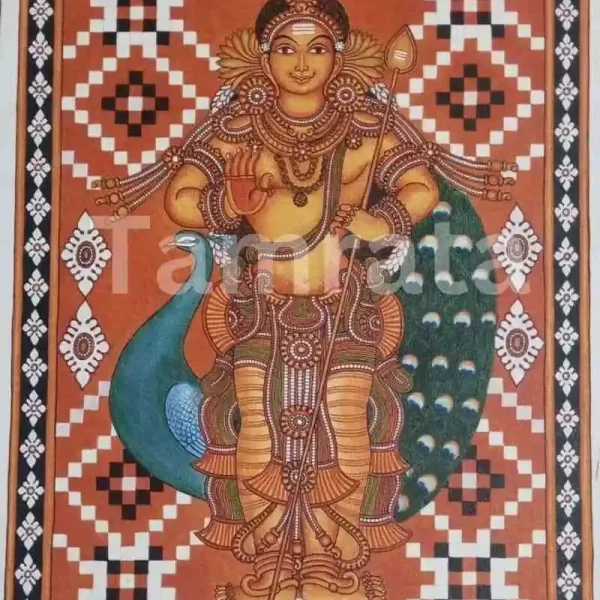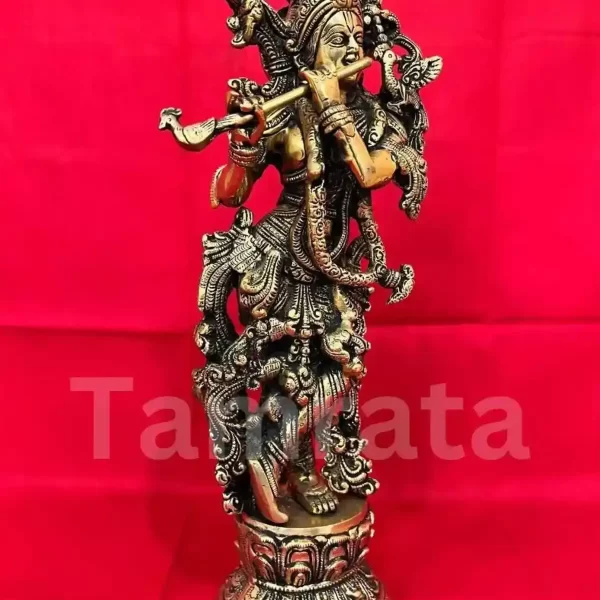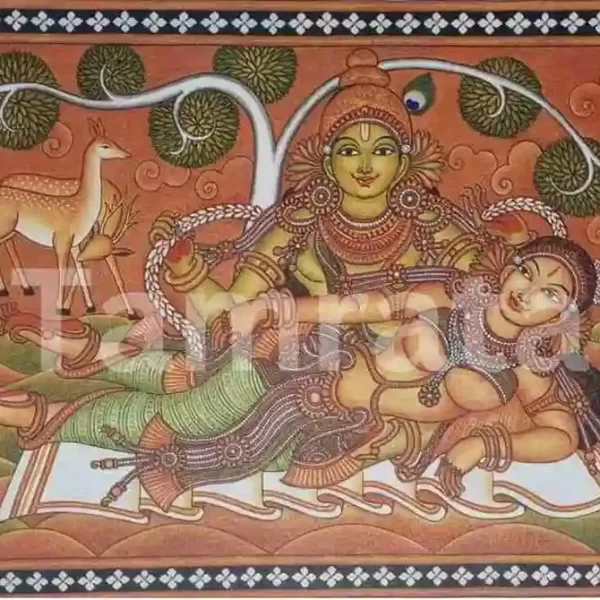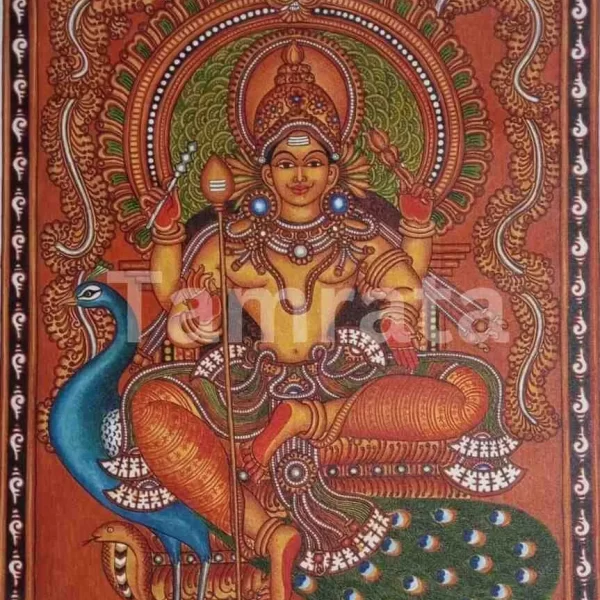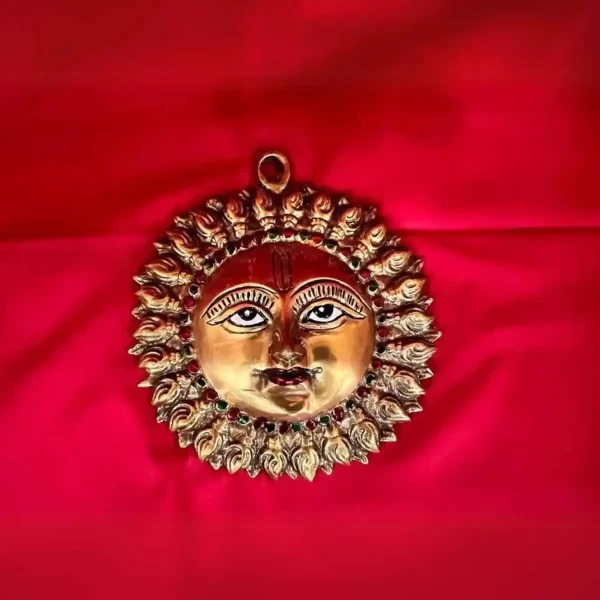
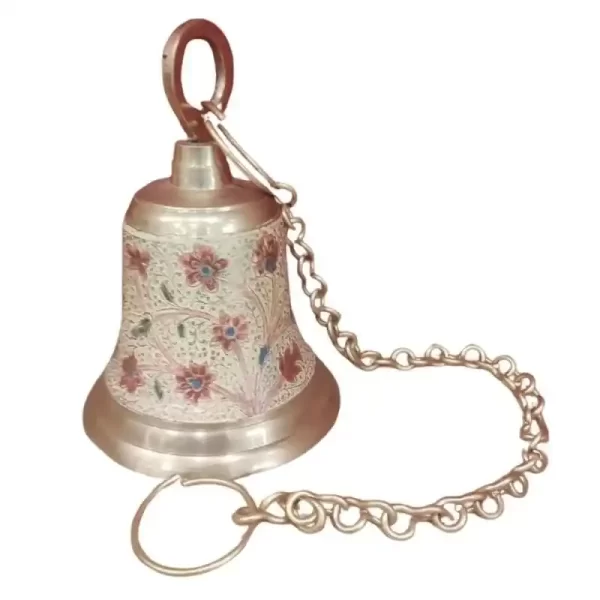
Buy Anantha shayanam With Dashavatharam Mural Painting | Kerala Canvas Painting | 3 × 5 sqft
Rs25,000.00 Price including taxes
Hand-Painted Kerala Traditional Mural Painting of Lord Maha Vishnu in Anantha Shayanam with Dasa Avatharam on 3 X 5 SqFt Canvas – Authentic Kerala Temple Art for Living Room, Pooja Room, and Temple Décor – Vibrant, Non-Framed Spiritual Wall Mural
Product Details
- Size Full
- Product Dimensions 3 x 5 SqFt
- Item Weight 1kg(max)
- Number of Items 1
- Orientation Landscape
- Shape Rectangular
- Theme Ananthas hayanam With Dasavatharam Mural Painting
- Recommended Uses indoor
- Frame Type Unframed
- Wall art form Mural Painting, Temple Art, Acrylic on Canvas
| Size |
3 x 5 SqFt |
|---|---|
| Weight |
1kg |
Anantha shayanam with Dasa avatharam | Handcrafted Kerala Traditional Art on 5 X 3 sqft Canvas | Vibrant Depiction of Lord Maha Vishnu’s Cosmic Sleep and Ten Divine Incarnations
Immerse yourself in the rich cultural heritage of Kerala with the “Anantha shayanam with Dasa avatharam” mural painting. This exquisite artwork is handpainted on a 3 × 5 sqft canvas using high-quality acrylic paints, capturing the essence of traditional Kerala mural painting. The painting beautifully combines two significant themes: Ananthashayanam, depicting Lord Vishnu in his cosmic sleep, and Dashavatharam, illustrating his ten divine incarnations. Each element is intricately detailed, showcasing the vibrant colors and artistic excellence of Kerala’s ancient art form. This mural is not just a piece of art but a reflection of India’s rich mythological history and cultural heritage.
Anantha shayanam
The Anantha shayanam theme is a captivating depiction of Lord Vishnu in his cosmic repose. The painting illustrates Lord Vishnu reclining on the serpent Adisesha, symbolizing his divine rest from which the universe is born. The serpent, with its multiple hoods, forms a protective canopy over Lord Vishnu. This scene is imbued with serenity and divinity, capturing the essence of cosmic balance and tranquility. Surrounding Vishnu are various gods, goddesses, and celestial beings, all meticulously detailed to enhance the painting’s spiritual narrative.
Dasa Avatharam
The Dasavatharam theme, also known as Dasavatharam, portrays the ten avatars of Lord Vishnu. According to Hindu mythology, these avatars were incarnations of Vishnu, each taken to restore cosmic order and righteousness. The ten incarnations are:
- Matsya (The Fish)
Matsya is the first avatar of Vishnu, where he took the form of a fish to save the sacred Vedas from a great flood. He also rescued the sage Manu and all the living beings by guiding them to safety.
- Kurma (The Tortoise)
In his second avatar, Vishnu became a tortoise to support Mount Mandara, which was used as a churning rod during the churning of the ocean (Samudra Manthan). His back provided a stable base for the mountain, enabling the Devas and Asuras to churn the ocean and obtain the nectar of immortality.
- Varaha (The Boar)
As Varaha, Vishnu appeared as a boar to rescue the Earth (personified as the goddess Bhudevi) from the demon Hiranyaksha, who had submerged it in the cosmic ocean. Varaha lifted the Earth on his tusks and restored it to its place in the universe.
- Narasimha (The Man-Lion)
Vishnu took the form of Narasimha, a half-man, half-lion, to protect his devotee Prahlada and destroy the demon king Hiranyakashipu, who was immune to being killed by man or beast, day or night, inside or outside. Narasimha killed the demon at twilight, on the threshold of his palace, with his lion claws.
- Vamana (The Dwarf)
In his fifth avatar, Vishnu appeared as a dwarf Brahmin named Vamana. He approached the demon king Bali and asked for three paces of land. Once granted, Vamana grew to enormous proportions and covered the earth, the heavens, and the underworld in three steps, thus restoring the balance of power.
- Parashurama (The Warrior with the Axe)
Parashurama, the sixth avatar, was a Brahmin warrior who wielded an axe. He is known for his mission to rid the world of corrupt Kshatriya rulers. Parashurama is depicted as a fierce warrior who restored dharma by defeating the unrighteous kings.
- Rama (The Prince)
As Rama, the seventh avatar, Vishnu took the form of a noble prince and king. The epic Ramayana tells the story of Rama’s life, his devotion to dharma, his exile, the abduction of his wife Sita by the demon king Ravana, and his eventual victory over Ravana with the help of his loyal companion Hanuman.
- Balarama (The Elder Brother of Krishna)
Balarama, the eighth avatar, is the elder brother of Krishna. He is depicted as a strong and powerful figure who wielded a plow as his weapon. Balarama played a significant role in the Mahabharata, supporting Krishna and the Pandavas in their quest for justice.
- Krishna (The Divine Statesman)
Krishna, the ninth avatar, is one of the most revered and widely worshipped deities in Hinduism. The epic Mahabharata and the Bhagavad Gita highlight his teachings and divine play. Krishna’s life includes his childhood exploits, his role as a charioteer and advisor to Arjuna, and his profound philosophical discourses.
- Kalki (The Future Warrior)
Kalki is the prophesied tenth avatar of Vishnu, who is yet to appear. According to Hindu belief, Kalki will come at the end of the current age of Kali Yuga, riding a white horse and wielding a sword. He will destroy the forces of evil, restore dharma, and inaugurate a new era of righteousness and virtue.
The Dashavatharam section of the mural presents these avatars in a dynamic and harmonious composition, illustrating their divine interventions and contributions to cosmic order.
Key Features
- Authentic Art: Traditional Kerala mural painting on canvas
- Intricate Details: Depicts Ananda Shayanam and Dasavatharam themes
- High Quality: Durable acrylic paint on a sturdy canvas
- Cultural Significance: Rich in Hindu mythology and Kerala heritage
Benefits
- Cultural Heritage: Adds a piece of Kerala’s ancient art tradition to your collection, celebrating India’s rich cultural heritage
- Aesthetic Appeal: Enhances any space with its vibrant colors and intricate details, making it a focal point of your decor
- Spiritual Connection: Depicts revered Hindu mythological themes, bringing a sense of divine presence and spiritual tranquility to your environment
- Durable Art: Crafted with durable materials, ensuring that the painting remains a cherished piece for years to come
Uses
- Home Decor: Perfect for adding a touch of elegance and cultural depth to living rooms, bedrooms, meditation spaces, and hallways
- Office Decor: Enhances the aesthetic appeal of office environments, creating a serene and inspiring atmosphere
- Gifting: Makes an ideal gift for art lovers, spiritual seekers, and those who appreciate cultural heritage, perfect for special occasions like housewarmings, weddings, and festivals
How to Clean
- Dust Regularly: Use a soft, dry cloth to gently dust the surface and maintain its vibrancy.
- Avoid Moisture: Keep the painting away from water and high humidity to prevent damage.
- Frame Protection: Consider framing the canvas to protect it from dust, moisture, and accidental damage.
- Avoid Direct Sunlight: Place the painting away from direct sunlight to prevent the colors from fading over time.
Bring home the divine beauty and cultural richness of Kerala with the “Anantha shayanam with Dasavatharam” mural painting.
Order now to add this exquisite piece of traditional art to your collection and experience the timeless elegance it brings!
Shipping Policy – Tamrata
- Delivery Charges varies with each region. Enter your pin code and can check them. Also low value items can have high shipping costs. The order summary will provide details.
- Shipping charges are calculated according to the factors like size, weight, volume, and delivery area.
- The delivery time depends on the availability of product, destination to be reached and delivery services to the area.
- There are no hidden charges in the product. All the billings will be included in order summary.
- The delivery to your location depends on delivery partner’s availability in your locations, legal restrictions if any and whether we ships to your location or not.
- Cash on Delivery services are currently not available as per our courier partner policy.
- For initiate a return, contact us. The procedure is simple. The amount will be charged nil if the product has any damage. If you changed your mind due to other reasons, you will be charged with courier charges. We will arrange the pickup.
- If there is a genuine product damage, the replacement product will be arranged asap after the pickup or cash back will be provided as per your choice.
- The price and delivery time to different countries for a same product may vary as the availability of international shipping timings.
- Tamrata now delivers inside India only and will soon start to spread the business all across the world step by step.
Related products
Buy Brass Unniyappam Making Pan | Unniyappa Kinnakkuzhi – A Touch of KeralaTradition
Brass Unniyappam Making Pan Online | Height 6cm Weight 0.2Kg Unniyappa Chatti | Traditional Brass paniyaram Pan
Product Details:
- Material: High-quality brass
- Capacity: 7 Multiple cavities for making several Unniyappams simultaneously
- Finish: Smooth, polished brass for even cooking and ease of maintenance
- Height :6cm
- Weight: 0.2Kg
- Suitable For: Pooja offerings, festive delicacies, traditional home cooking
- Design: Handcrafted by expert artisans, reflecting the excellence of brass artifacts
Buy Hand Painted GovardhanaKannan Mural Painting | Kerala Traditional Murals
Buy Hand Painted Govardhana Kannan Mural Painting | Authentic Kerala Traditional Murals | 26" x 18" Portrait for Home Decor, Temples, and Meditation Spaces | Traditional Murals | Kerala Temple Art
Key Features:
- Authentic Kerala Traditional Mural Painting
- Hand-painted on high-quality canvas
- Dimensions: 26" x 18" (Portrait)
- Depicts the divine Govardhana Kannan lifting Govardhana Hill
- Vibrant colors and intricate detailing
- Perfect for home decor, temples, and meditation spaces
Buy Velayudhan Mural Painting | Hand Painted Kerala Mural Art
Buy Velayudhan Mural Painting | Hand Painted Kerala Mural Art | Buy Kerala Mural Painting | Buy Mural Paintings Online | 25'' X 17'' Mural Art
Uses:- Home Décor: Enhance your living space with cultural richness.
- Art Collection: Perfect for enthusiasts and collectors.
- Gift Idea: Share traditional art and cultural heritage with loved ones.
Hand Painted Panchuruli Mural Art | Kerala Traditional Wall Art
Buy Hand Painted Panchuruli Mural Art | Buy Kerala Mural Painting | Traditional Art | Wall Decor | Paintings For Wall | Temple Art | 23" X 19" Mural Painting
Key Features :
- Authentic Kerala mural artistry.
- Intricate hand-painted designs.
- Vibrant and durable colors.
- Customizable sizes and designs available.
- Premium quality materials used.
- Suitable for home, office, or cultural spaces.
- Perfect for gifting on special occasions.
Krishna Brass Statue | Kerala Traditional Handcrafted Pure Brass Sri Krishna Murti Online
Exquisite Handcrafted Krishna Brass Statue | Kerala Traditional Handcrafted Pure Brass Sri Krishna Murti Online | Divine Lord Krishna Idol for Home Decor and Worship | Antique Finish, Intricate Details, 36cm Height 4Kg
Product Details
- Material: Premium quality brass
- Height: 36 cm
- Weight: 4 Kg (approximately)
- Finish: Antique brass finish, highlighting intricate details
- Design: Handcrafted by skilled artisans, showcasing traditional artistry
Radha and Krishna Mural Painting | Hand Painted Mural Art
Buy Radha And Krishna Mural Painting | Kerala Mural Art Painting | Kerala Temple Art and Traditional Wall Art | 27" X 18" | Buy Mural Painting
Key Features :
- Hand-painted by skilled artisans
- Captures the essence of Kerala mural art
- Features Radha and Krishna in intricate detail
- Adds cultural and spiritual depth to any space
- Perfect for home decor and sacred spaces
- Ideal gift for weddings and housewarmings
- Enhances the ambiance of temples and meditation rooms
Shiva & Mohini Mural Paintings |Hand Painted Kerala Mural Art
Buy Hand painted Shiva And Mohini Mural | Kerala Traditional Temple Art | Premium Home Decor | 28" X 19" Mural
Key Features:
- Authentic Kerala mural art
- Divine imagery of Lord Shiva and Mohini
- Ideal size for display in homes and temples
- Represents Kerala's cultural heritage
- Skilled artisan craftsmanship
- Vibrant and life-like colors
- Excellent for premium gifting
Sri Murugan Mural Painting | Hand Painted Kerala Wall Decor
Buy Sri Murugan Mural Painting |Kerala Traditional Hand Painted Mural Art | Buy Mural Painting | Wall Hanging Decor | Mythological Art & Spiritual Wall Decor
Key Features:
- Vibrant depiction of Sri Murugan with symbolic imagery.
- Intricate detailing and rich, enduring colors.
- Spiritual and mythological narrative.
- Enhances cultural spaces and spiritual ambiance.
- Ideal for home decor, temples, and meditation rooms.
- Crafted with meticulous artistry and reverence.
- Perfect gift for spiritual occasions and art enthusiasts.

